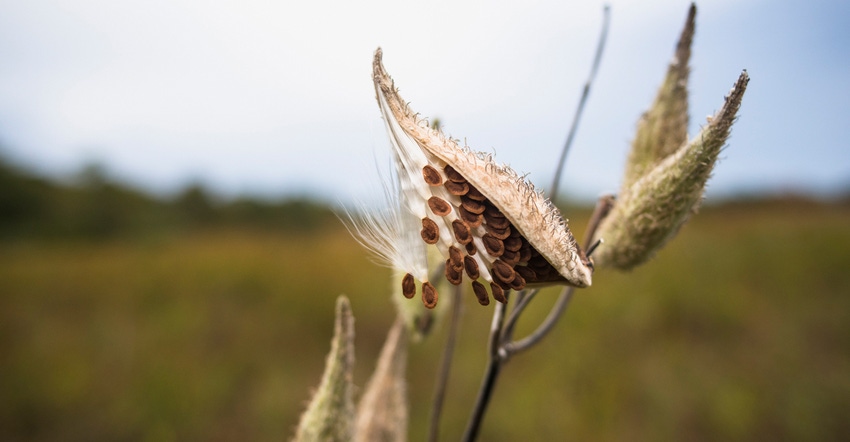October 19, 2018

Farmers are in a unique position to ensure that monarchs have plenty of milkweed by planting it in noncrop areas of their land. Whether farmers received their milkweed from the Living Acres #MonarchChallenge or they have been letting milkweed grow naturally, they still have the ability to propagate even more milkweed this fall.
Milkweed, the essential plant for the monarch butterfly life cycle and the sole food source for the monarch caterpillar, has become less common over the years, primarily due to habitat loss. As abundant fields and meadows have turned into parking lots and developments, the places where milkweed grew naturally have disappeared, leading to a decrease in monarch butterfly populations.
Plant seed, grow your own plants
“Whether you have milkweed in your ditches, gardens or grasslands, the plant could already be present on your property,” says Laura Vance, BASF biology project leader.
Now is the perfect time to propagate even more milkweed. To identify the plant, use the simple test of snapping off a leaf from the milkweed plant, and a white, paint-like liquid should appear. It’s called latex, and it really does look like white latex paint. However, don’t touch it. The foam is a skin irritant, so be sure to wear gloves.
“With the air getting crisp, milkweed seed pods should be turning a green-yellow,” Vance says. “By the time the pods turn brown, they often are split open and have released their seeds.”
The best way to tell if the seeds are mature is to exert slight pressure on the pod. It’ll split open down the front and reveal dark brown seeds. If the seeds are green or light brown, then they aren’t ready to be harvested. Leave the pod on for a few more days and check back again.
Propagate milkweed now
Once the seeds are mature, pluck the entire seed pod off the plant. You can either store the entire pod in a paper bag for the winter or remove the white fluff right away. You can separate the fluff from the seeds simply by emptying the contents of the pod into a paper bag or container.
Drop in a couple pennies and shake the bag. The pennies help separate the fluff from the seeds easily. Otherwise, depending on how many pods you’ve collected, you can pull the fluff from each individual seed.
Butterflies important pollinators
Whether the seeds are defluffed or remain in their pod, they should be stored in a cool place, such as a refrigerator, so they can stratify over the winter and be ready to plant come spring.
Following these steps to harvest milkweed seeds is a great way to give monarch caterpillars more of the only food source they so desperately need. By helping plant more milkweed across the U.S., you can help the monarch butterflies thrive once more.
To get more information about milkweed and monarch butterflies, visit monarchchallenge.com and sign up for the newsletter. The #MonarchChallenge was created by Living Acres, a BASF biodiversity initiative, to spread awareness on the decreasing monarch population, including ways farmers and farm families can help by planting milkweed on noncrop areas of their land.
Source: BASF
You May Also Like




